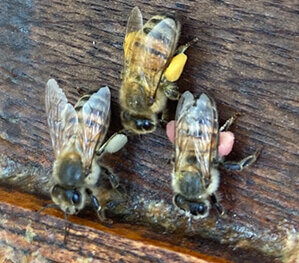Letters to the Editor
Letters to the Editor – May 2023

Today’s menu specials!
Teresa Munn sent this photo from East Texas, about midway between Canton and Athens.
Taken with her iPhone (which she also used to call the Editor), the image provides a beautiful contrast between incoming pollens.
Teresa said it’s difficult to pinpoint the exact pollen sources during the first week of March when this was taken, though redbud seems likely for the pink. Other blooming species included various wildflowers, and several trees including elm and honey locust — the latter with the long thorns that “will pop your tires!”
A Chatbot Talks Beekeeping
I always appreciate the writings of Rusty Burlew. I am glad she picked up the topic of AI-generated text [“Beekeeping in the words of an AI Chatbot,” March]; now I don’t have to write about it myself. I experimented with it, as perhaps all writers have done by now, and came to the same conclusions as Rusty.
She says: “AI-generated text may be less coherent and may not flow as naturally as human-written text.” I would like to add to that. Writers like Rusty and me go out of our way to not only be coherent and flowing, but more importantly: We try to be interesting. Our work is not just to assemble information but to dig through it and find the unusual, the unexpected, the surprising. For the AI, the standard is “good enough.”
Reminds me of the words of a professor my wife had. The prof said that if the students did all the work, got perfect scores on all the tests, etc. they could hope for a “B.” To get an “A” they would need to do more than that.
Peter L Borst
Ithaca, NY


